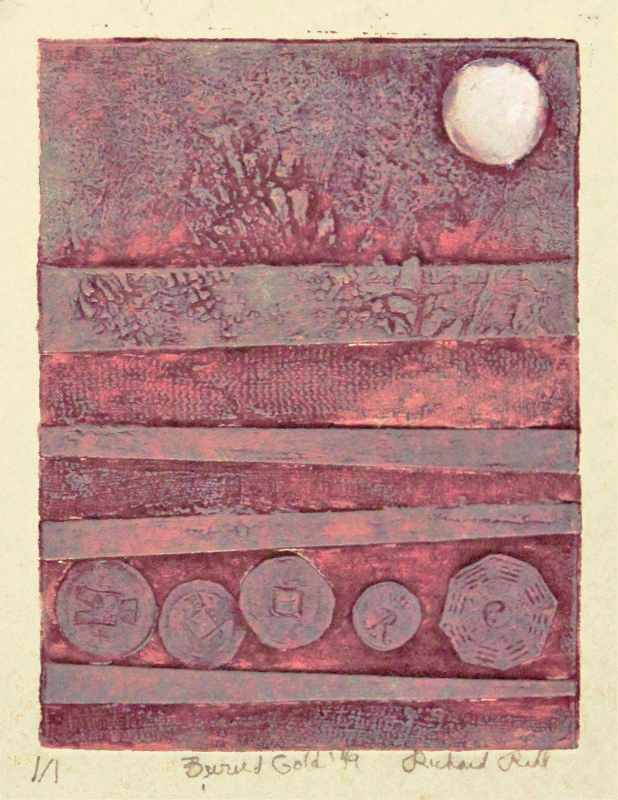Buried Gold is a color collagraph created in 1949 by American artist Richard Redd. Buried Gold is pencil signed, titled, dated and numbered 1/1. It was printed by the artist on a textured buff Canon Mi Tientes paper and the platemark measures 7-3/8 x 5-11/16 inches.
A collagraph is created by affixing different materials to a matrix resulting in a textured surface. When the plate is inked the textures hold varying amounts of ink depending upon their height or depth. For his collagraph Buried Gold, Redd used coins and other objects to add interest and texture to his image. The glowing circle in the upper right might read as the moon illuminating the landscape. The earth’s strata is suggested by the stacked, slightly vertical lines beneath which are buried ancient coins, or buried gold.
Richard Redd, painter, printmaker, and educator, was born on 22 October 1931 in Toledo, Ohio. He graduated from the University of Toledo in 1953 with a B.Ed in Education. He taught briefly at the elementary level before serving the in the U.S. Army for two years. In 1958, he earned his MFA degree from the University of Iowa where he studied printmaking under Lithuanian-Argentinean printmaker, Mauricio Lasansky.
Redd began teaching at Lehigh University in 1958 and was promoted to Associate Professor in 1968; he remained on the faculty for thirty-eight years. He received the student body Outstanding Teacher Award in 1968. From 1969 to 1974 he was director of The Globus Series in Creative Arts which was responsible for bringing multimedia and participatory arts events to the campus in theater, dance, music and visual arts. Redd served as chairman of the department of Art and Architecture from 1970 to 1976, as well as acting as interim chair on several occasions.
Redd was a past president and a board member of the Lehigh Art Alliance and served on the board of the Annie S. Kemerer Museum [now the Kremerer Museum of Decorative Arts] for eleven years, curating many exhibits. He was a member of the Allentown Art Museum where a solo exhibition of his work was mounted in 1961. Redd served on the board of the Printmaking Council of New Jersey and was a member of the American Color Print Society.
A seemingly tireless individual and artist, Redd worked in fiber, oil, encaustic, color xerography, and collagraph printmaking. He turned to printmaking exclusively in 1984. He showed at the Raab Gallery in Philadelphia and the Jacques Seligman Gallery in New York. He showed his work and that of other printmakers at his Reddstone Gallery at his residence on Stonesthrow Road in Lower Saucon Township.
He was honored by the Bethlehem Fine Arts Commission in 1994 as the 4th recipient of its annual award recognizing service to the arts. In 2005 there was a retrospective of his prints at the Banana Factory in Bethlehem, Pennsylvania. The Richard Redd Award was created by the Department of Art, Architecture and Design in 2013. This award is given annually to a department major who contributes substantively to the cultural life of the department.
Redd retired in 1996 and lived in Bethlehem, Pennsylvania where he continued working, He died in Jenkintown, Pennsylvania on 26 November 2017.



